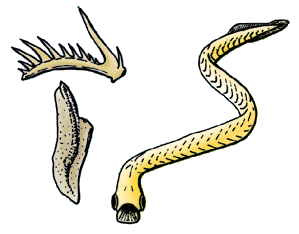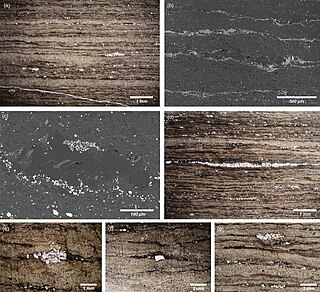Related Research Articles
The Ordovician is a geologic period and system, the second of six periods of the Paleozoic Era. The Ordovician spans 41.6 million years from the end of the Cambrian Period 485.4 million years ago (Mya) to the start of the Silurian Period 443.8 Mya.

Conodonts are extinct agnathan chordates resembling eels, classified in the class Conodonta. For many years, they were known only from tooth-like microfossils found in isolation and now called conodont elements. Knowledge about soft tissues remains limited. The animals are also called Conodontophora to avoid ambiguity.

Promissum is an extinct genus of conodonts, primitive chordates, that lived during the Upper Ordovician period.
Archaeognathus is a fossilized jaw apparatus from the Ordovician that has been compared to the conodonts and vertebrates, yet remains unclassified.
Prioniodontida, also known as the "complex conodonts", is a large clade of conodonts that includes two major evolutionary grades; the Prioniodinina and the Ozarkodinina. It includes many of the more famous conodonts, such as the giant ordovician Promissum (Prioniodinina) from the Soom Shale and the Carboniferous specimens from the Granton Shrimp bed (Ozarkodinina). They are euconodonts, in that their elements are composed of two layers; the crown and the basal body, and are assumed to be a clade.

The Soom Shale is a member of the Late Ordovician (Hirnantian) Cederberg Formation in South Africa, renowned for its remarkable preservation of soft-tissue in fossil material. Deposited in still waters, the unit lacks bioturbation, perhaps indicating anoxic conditions.
Periodon is a genus of conodonts which existed in what is now Canada, Iran, Argentina, China, Russia, and the United States during the Ordovician Period. It was described by Hadding in 1913, and the type species is P. aculeatus.
Westergaardodina is a species-rich genus of spine, U or W-shaped paraconodont known from Middle Cambrian to Lower Ordovician strata.
Iapetognathus is a genus of cordylodan conodonts. It is one of the oldest denticulate euconodont genera known.
Chirognathidae is an extinct family of conodonts.
Balognathidae is an extinct conodont family.
Notiodella is an extinct conodont genus in the family Balognathidae. It has been described from a 17-element apparatus from the Soom Shale Lagerstätte in South Africa.
Paracordylodus is an extinct genus of conodonts in the clade Prioniodontida, also known as the "complex conodonts". The species P. gracilis has been recovered from the chert of the Narooma Terrane, a geological structural region on the south coast of New South Wales, Australia.
Appalachignathus is a genus of multielement conodonts from the Middle Ordovician of North America.

Acanthodus is an extinct genus of conodonts.
Kallidontus is an extinct genus of conodonts.
Utahconus is an extinct genus of conodonts.

Variabiloconus is an extinct genus of conodonts.
Microzarkodina is an extinct genus of conodonts mainly from the Middle Ordovician of Baltoscandia. The Microzarkodina apparatus probably consisted of 15 or 17 elements: four P, two or four M and nine S elements. The S elements include different Sa, Sb1, Sb2, and Sc element types.
Scotlandia is an extinct genus of conodonts in the family Prioniodinidae.
References
- ↑ Stratigraphical distribution of the Ordovician conodont Erraticodon Dzik in Argentina. S. Heredia, J. Carlorosi, A. Mestre and T. Soria, Journal of South American Earth Sciences, Volume 45, August 2013, Pages 224–234, doi : 10.1016/j.jsames.2013.03.012
- ↑ Revision of the conodont Erraticodon hexianensis from the upper Meitan Formation (Middle Ordovician) of Guizhou, South China. Yong Yi Zhen, Jianbo Liu and Ian G. Percival, Paleontological Research, 11(2), pages 145-162, 2007, doi : 10.2517/1342-8144(2007)11[145:ROTCEH]2.0.CO;2